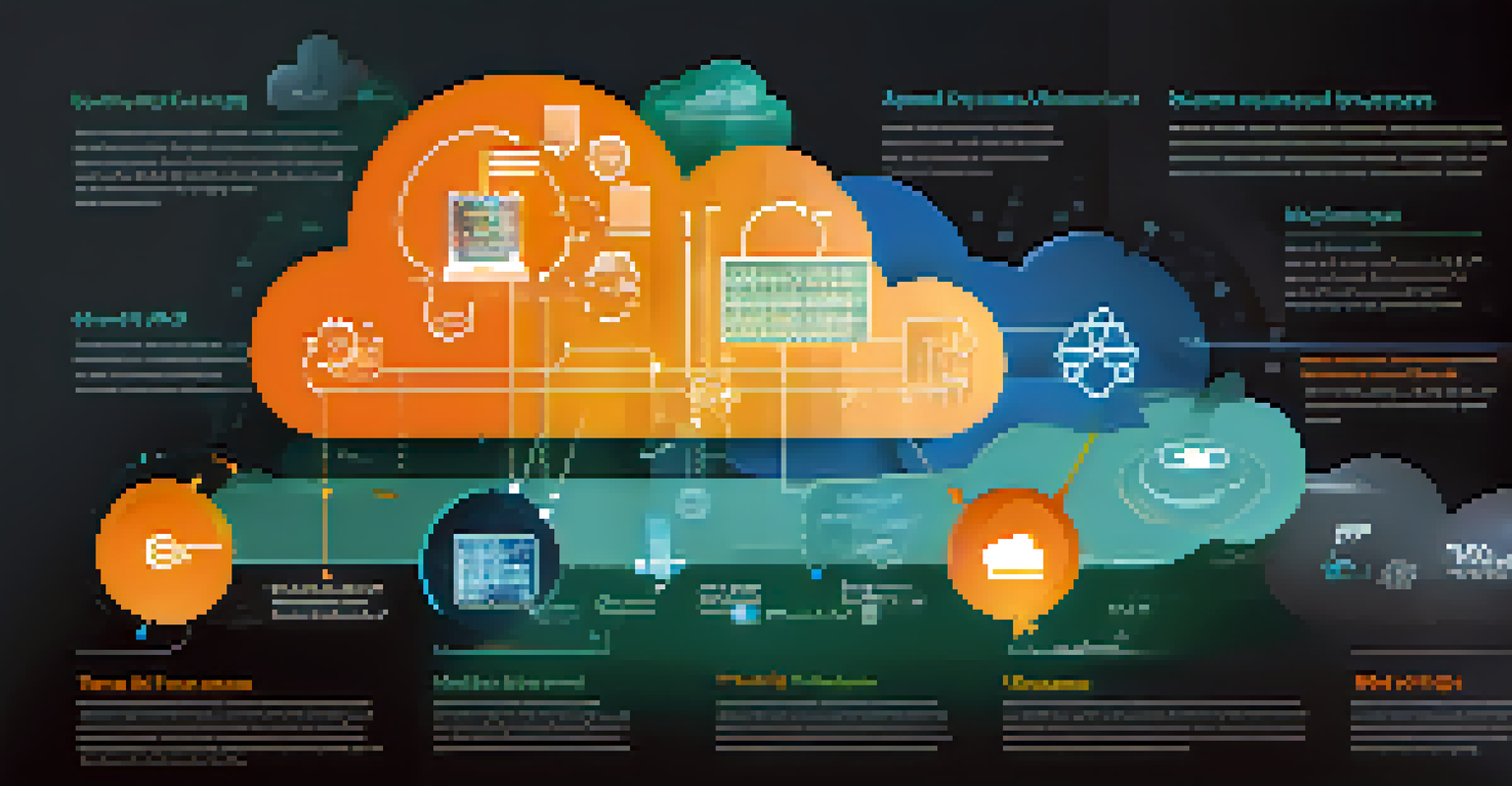Key Providers of Serverless Computing Solutions Explained

Understanding Serverless Computing and Its Benefits
Serverless computing is a cloud computing model that allows developers to build and run applications without managing the infrastructure. The name can be a bit misleading since servers are still involved; however, the complexity of server management is abstracted away from the user. This means developers can focus more on writing code and less on server maintenance, which can lead to faster deployment and innovation.
Serverless computing is a game changer for developers, allowing them to focus on building applications rather than managing infrastructure.
One of the biggest advantages of serverless computing is its scalability. When demand spikes, serverless solutions automatically allocate resources to handle the increase without any manual intervention. This elasticity not only enhances performance but also ensures that users only pay for the resources they actually consume, making it a cost-effective option for businesses of all sizes.
Moreover, serverless architectures often increase development speed. Developers can deploy updates and new features quickly, as they can concentrate purely on application logic rather than the underlying infrastructure. By simplifying the development process, serverless computing allows teams to innovate more rapidly and respond to market changes with agility.
Amazon Web Services (AWS) Lambda: A Front-Runner
AWS Lambda is one of the most well-known serverless computing platforms, allowing users to execute code in response to events without provisioning servers. It's a cornerstone of AWS's broader cloud offerings and integrates seamlessly with other AWS services, making it a go-to choice for many businesses. Users can write functions in various programming languages, including Node.js, Python, and Java, making it flexible for diverse development needs.

One standout feature of AWS Lambda is its automatic scaling. As your application grows, Lambda can handle an increase in requests without any manual scaling efforts. This feature is particularly beneficial during unpredictable traffic spikes, ensuring that users experience minimal latency and downtime.
Benefits of Serverless Computing
Serverless computing enables developers to focus on code rather than infrastructure, enhancing scalability, cost-effectiveness, and development speed.
Additionally, AWS Lambda offers a pay-per-use pricing model, meaning users are billed only for the compute time they consume. This model can significantly reduce costs for applications with variable workloads, allowing startups and enterprises to manage their budgets more effectively while using a robust infrastructure.
Google Cloud Functions: A Developer's Delight
Google Cloud Functions is another popular serverless computing option that enables developers to run code in response to cloud events. This service is designed to simplify the process of developing and deploying applications, offering a user-friendly interface that appeals to developers. Like AWS Lambda, it allows for a variety of programming languages, making it accessible for teams with different technical backgrounds.
The beauty of serverless architectures is that they offer flexibility, scalability, and cost-effectiveness, making them ideal for today's fast-paced digital landscape.
One of the key strengths of Google Cloud Functions is its tight integration with other Google Cloud services, such as Pub/Sub and Firestore. This makes it particularly effective for building event-driven architectures, where applications react to changes in real-time. Developers can create sophisticated workflows that respond dynamically to user interactions or data changes without much overhead.
In addition, Google Cloud Functions provides automatic scaling, which means that it can effortlessly handle varying loads. This feature is essential for applications with unpredictable traffic patterns, allowing businesses to maintain performance without overprovisioning resources.
Microsoft Azure Functions: Flexible and Robust
Microsoft Azure Functions is a robust serverless computing platform that offers a wide range of functionalities for developers. It supports multiple programming languages, including C#, JavaScript, and Python, allowing developers to use their preferred tools while building applications. Azure Functions are particularly known for their ability to respond to various triggers, such as HTTP requests, timers, or changes in data.
A key benefit of Azure Functions is its seamless integration with other Azure services, which enhances its capabilities in building complex applications. This integration allows developers to easily connect their serverless functions with databases, storage solutions, and AI services, creating a powerful ecosystem for application development.
Major Serverless Platforms
Leading serverless platforms like AWS Lambda, Google Cloud Functions, and Microsoft Azure Functions provide robust, scalable solutions that integrate seamlessly with other services.
Furthermore, Azure Functions offers a consumption-based pricing model, meaning users only pay for the compute resources they use. This pricing structure helps organizations control costs while still providing the flexibility they need to innovate and scale their applications as required.
IBM Cloud Functions: Open Source and Versatile
IBM Cloud Functions stands out in the serverless arena due to its support for open-source principles. Based on Apache OpenWhisk, this platform allows developers to run code in response to events while enjoying the flexibility of open-source technology. This means that organizations can customize and extend their serverless solutions according to their specific needs without being locked into a particular vendor.
One of the notable features of IBM Cloud Functions is its ability to manage and orchestrate complex workflows. Developers can create sequences of actions that trigger based on various events, enabling sophisticated applications that can handle intricate business logic. This capability is particularly useful for enterprises that require high levels of customization and control over their serverless functions.
Moreover, IBM Cloud Functions offers a pay-as-you-go pricing model, ensuring that businesses only pay for the resources they utilize. This approach is not only cost-effective but also encourages experimentation and innovation, as teams can test new ideas without worrying about upfront infrastructure costs.
Serverless Frameworks: Simplifying Development
In addition to the major providers, various serverless frameworks have emerged to simplify the development and deployment of serverless applications. These frameworks, such as Serverless Framework, AWS SAM, and Google Cloud Functions Framework, offer tools and templates that streamline the process. They enable developers to focus on writing code rather than managing complex configurations and deployments.
One significant advantage of using a serverless framework is the ability to manage multiple cloud environments with ease. Developers can write their code once and deploy it across various platforms, ensuring flexibility and reducing vendor lock-in. This cross-platform functionality allows organizations to choose the best services for their specific needs while maintaining a consistent development experience.
Real-World Applications
Serverless computing is transforming industries by allowing businesses to build scalable applications and streamline operations, particularly benefiting e-commerce and startups.
Additionally, serverless frameworks often include built-in monitoring and debugging tools, making it easier for developers to track performance and troubleshoot issues. This support is invaluable for maintaining application reliability and ensuring that serverless functions operate as intended, providing peace of mind to developers and organizations alike.
Real-World Applications of Serverless Computing
Serverless computing is not just a trendy buzzword; it has real-world applications that are transforming how businesses operate. Companies across various industries are leveraging serverless architectures to build scalable applications, automate workflows, and streamline their operations. For instance, e-commerce platforms can use serverless functions to handle fluctuating traffic during sales events without worrying about infrastructure costs.
Another example can be found in the media industry, where serverless computing is utilized for video processing and streaming. By processing video files in a serverless environment, companies can scale their operations according to demand, ensuring smooth user experiences during peak times. This flexibility is crucial for maintaining customer satisfaction in a fast-paced digital landscape.

Moreover, startups are increasingly adopting serverless computing to launch their products quickly and efficiently. By using serverless solutions, they can minimize upfront costs and reduce the time to market, allowing them to focus on product development and customer acquisition. This agility is a significant advantage for new businesses looking to disrupt established markets.
The Future of Serverless Computing: What Lies Ahead
As serverless computing continues to gain traction, its future appears bright with numerous possibilities. We can expect further advancements in automation, AI integration, and multi-cloud capabilities, enabling developers to create even more sophisticated applications. These developments will likely enhance the overall user experience and broaden the range of applications that can be built using serverless technologies.
Additionally, as organizations become more aware of the benefits, we may see a shift in how companies structure their IT departments. Serverless architectures can empower smaller teams to manage large-scale applications, changing the traditional roles of developers and system administrators. This shift could lead to a more agile and innovative approach to software development.
Ultimately, the growth of serverless computing could redefine the cloud landscape, driving competition among providers and encouraging continuous improvement in services. As more businesses adopt serverless solutions, the industry will likely evolve, leading to new opportunities and challenges that will shape the future of cloud computing.